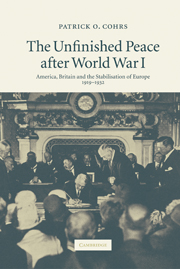Book contents
- Frontmatter
- Contents
- Acknowledgements
- List of abbreviations
- A note on the footnotes and bibliography
- Introduction
- Prologue
- 1 The wider challenges
- 2 Wilson, Lloyd George and the quest for a ‘peace to end all wars’
- 3 The ill-founded peace of 1919
- 4 The escalation of Europe's post-Versailles crisis, 1920–1923
- Part I The Anglo-American stabilisation of Europe, 1923–1924
- Part II Europe's nascent Pax Anglo-Americana, 1924–1925
- Part III The unfinished transatlantic peace order: the system of London and Locarno, 1926–1929
- Epilogue
- Conclusion
- Map: Post-World War I Europe after the peace settlement of Versailles
- Bibliography
- Index
2 - Wilson, Lloyd George and the quest for a ‘peace to end all wars’
Published online by Cambridge University Press: 21 July 2009
- Frontmatter
- Contents
- Acknowledgements
- List of abbreviations
- A note on the footnotes and bibliography
- Introduction
- Prologue
- 1 The wider challenges
- 2 Wilson, Lloyd George and the quest for a ‘peace to end all wars’
- 3 The ill-founded peace of 1919
- 4 The escalation of Europe's post-Versailles crisis, 1920–1923
- Part I The Anglo-American stabilisation of Europe, 1923–1924
- Part II Europe's nascent Pax Anglo-Americana, 1924–1925
- Part III The unfinished transatlantic peace order: the system of London and Locarno, 1926–1929
- Epilogue
- Conclusion
- Map: Post-World War I Europe after the peace settlement of Versailles
- Bibliography
- Index
Summary
How did Wilson and Lloyd George intend to cope with these wider challenges? How and how far did they perceive them and the more immediate problems of 1918, all crystallising around the German question? How precisely did they envisage forging a ‘peace to end all wars’? To explore this, not only their goals and strategies must be compared. It also has to be re-assessed on what assumptions each statesman operated, against which constraints each sought to legitimate his endeavours and what lessons each had drawn from the Great War.
Towards a new world order? The aspirations and limits of Wilson's Progressivism
The alleged ‘failure’ of Wilson's peace policy at Versailles was already widely highlighted at the time, not least during the ratification debates in the US Senate. In the eyes of Keynes and other liberal critics the problem lay not with the tenets of Wilsonianism itself but the fact that they had been compromised at Versailles, essentially by the machinations of European power politics as practised by Lloyd George and Clemenceau. Keynes' verdict was that Wilson's inability to make his interlocutors accept his laudable programme contributed decisively to the ‘Carthaginian peace’. More clout, though, have had subsequent ‘realist’ condemnations of Wilson's approach. As we have seen, Morgenthau, Lippmann and their followers claimed that Wilsonianism was not viable because it failed to appreciate that world politics was governed by the balance of power.
- Type
- Chapter
- Information
- The Unfinished Peace after World War IAmerica, Britain and the Stabilisation of Europe, 1919–1932, pp. 30 - 45Publisher: Cambridge University PressPrint publication year: 2006



